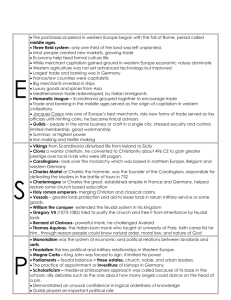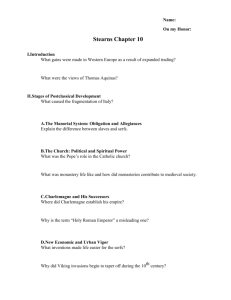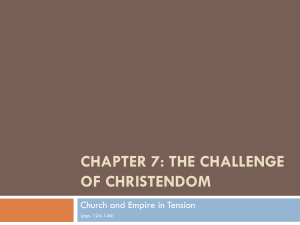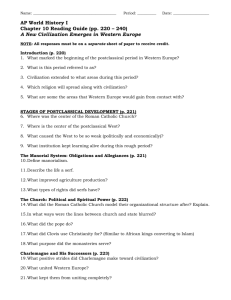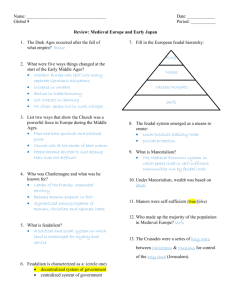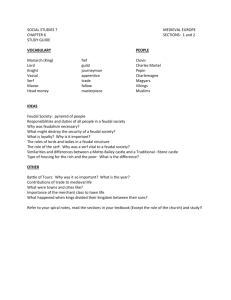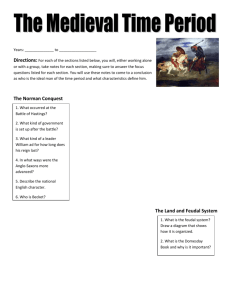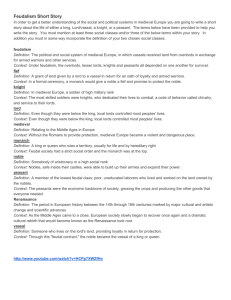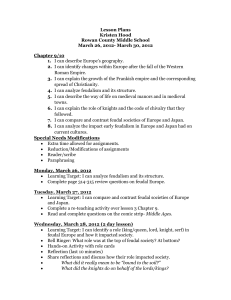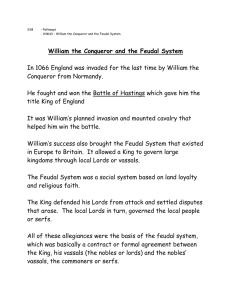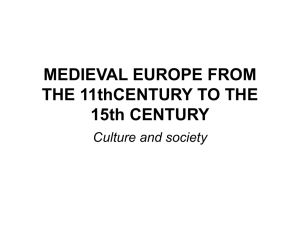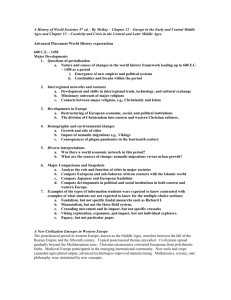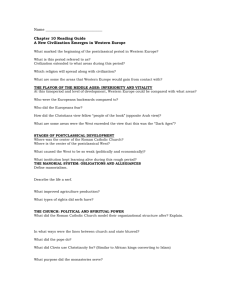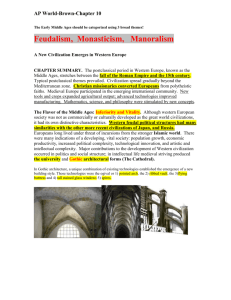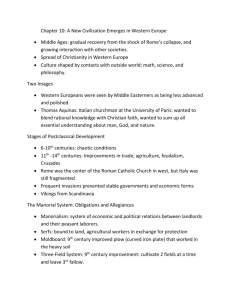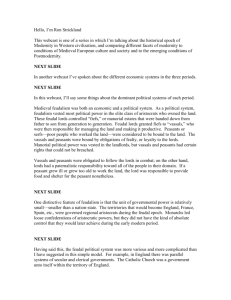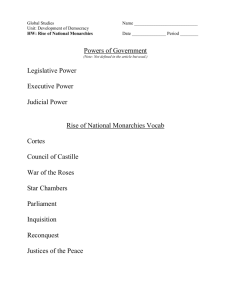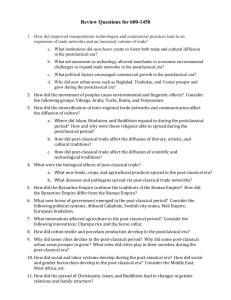Chapter 10 Review
advertisement
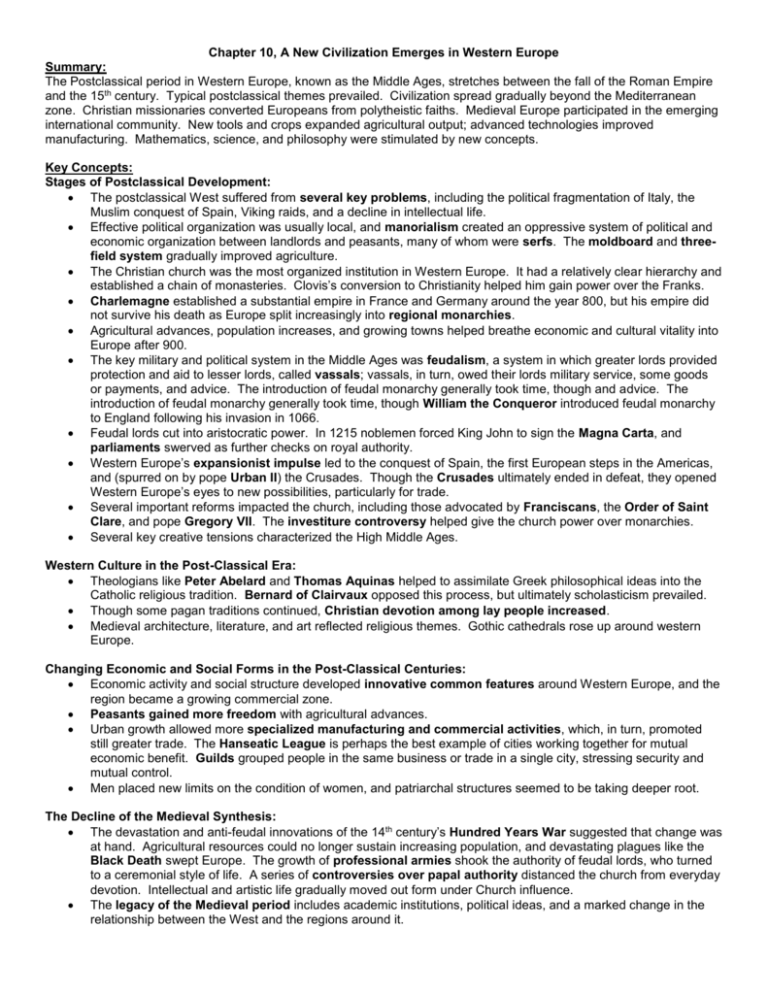
Chapter 10, A New Civilization Emerges in Western Europe Summary: The Postclassical period in Western Europe, known as the Middle Ages, stretches between the fall of the Roman Empire and the 15th century. Typical postclassical themes prevailed. Civilization spread gradually beyond the Mediterranean zone. Christian missionaries converted Europeans from polytheistic faiths. Medieval Europe participated in the emerging international community. New tools and crops expanded agricultural output; advanced technologies improved manufacturing. Mathematics, science, and philosophy were stimulated by new concepts. Key Concepts: Stages of Postclassical Development: The postclassical West suffered from several key problems, including the political fragmentation of Italy, the Muslim conquest of Spain, Viking raids, and a decline in intellectual life. Effective political organization was usually local, and manorialism created an oppressive system of political and economic organization between landlords and peasants, many of whom were serfs. The moldboard and threefield system gradually improved agriculture. The Christian church was the most organized institution in Western Europe. It had a relatively clear hierarchy and established a chain of monasteries. Clovis’s conversion to Christianity helped him gain power over the Franks. Charlemagne established a substantial empire in France and Germany around the year 800, but his empire did not survive his death as Europe split increasingly into regional monarchies. Agricultural advances, population increases, and growing towns helped breathe economic and cultural vitality into Europe after 900. The key military and political system in the Middle Ages was feudalism, a system in which greater lords provided protection and aid to lesser lords, called vassals; vassals, in turn, owed their lords military service, some goods or payments, and advice. The introduction of feudal monarchy generally took time, though and advice. The introduction of feudal monarchy generally took time, though William the Conqueror introduced feudal monarchy to England following his invasion in 1066. Feudal lords cut into aristocratic power. In 1215 noblemen forced King John to sign the Magna Carta, and parliaments swerved as further checks on royal authority. Western Europe’s expansionist impulse led to the conquest of Spain, the first European steps in the Americas, and (spurred on by pope Urban II) the Crusades. Though the Crusades ultimately ended in defeat, they opened Western Europe’s eyes to new possibilities, particularly for trade. Several important reforms impacted the church, including those advocated by Franciscans, the Order of Saint Clare, and pope Gregory VII. The investiture controversy helped give the church power over monarchies. Several key creative tensions characterized the High Middle Ages. Western Culture in the Post-Classical Era: Theologians like Peter Abelard and Thomas Aquinas helped to assimilate Greek philosophical ideas into the Catholic religious tradition. Bernard of Clairvaux opposed this process, but ultimately scholasticism prevailed. Though some pagan traditions continued, Christian devotion among lay people increased. Medieval architecture, literature, and art reflected religious themes. Gothic cathedrals rose up around western Europe. Changing Economic and Social Forms in the Post-Classical Centuries: Economic activity and social structure developed innovative common features around Western Europe, and the region became a growing commercial zone. Peasants gained more freedom with agricultural advances. Urban growth allowed more specialized manufacturing and commercial activities, which, in turn, promoted still greater trade. The Hanseatic League is perhaps the best example of cities working together for mutual economic benefit. Guilds grouped people in the same business or trade in a single city, stressing security and mutual control. Men placed new limits on the condition of women, and patriarchal structures seemed to be taking deeper root. The Decline of the Medieval Synthesis: The devastation and anti-feudal innovations of the 14th century’s Hundred Years War suggested that change was at hand. Agricultural resources could no longer sustain increasing population, and devastating plagues like the Black Death swept Europe. The growth of professional armies shook the authority of feudal lords, who turned to a ceremonial style of life. A series of controversies over papal authority distanced the church from everyday devotion. Intellectual and artistic life gradually moved out form under Church influence. The legacy of the Medieval period includes academic institutions, political ideas, and a marked change in the relationship between the West and the regions around it. Key Terms: Three Estates Scholasticism Magna Carta Charlemagne Three-Field System Manorialism Romanesque Pope Urban II Vikings Ferdinand & Isabella Essay Questions: 1. Define manorialism and feudalism. How do they provide the building blocks for medieval political structure and society? 2. What were the characteristics of feudal monarchy as demonstrated in France and England between 1000 and 1300? 3. How did the theological outlook of Western Europe change between 1000 and 1400? 4. What were the developments that led to increases in monarchic power at the end of the Middle Ages? How was royal authority limited?
